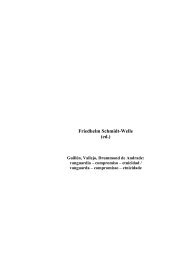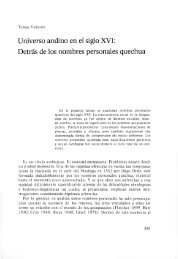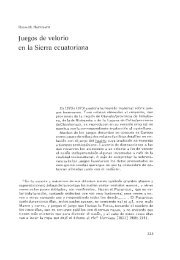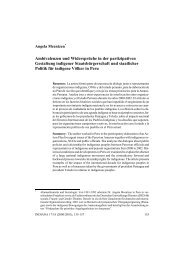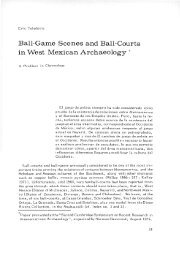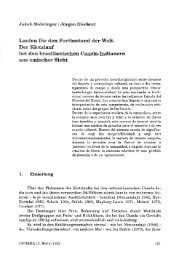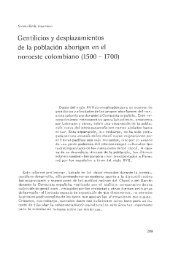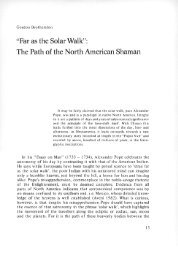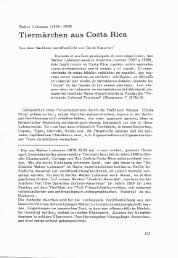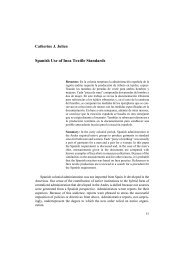Time and Script in Ancient Mesoamerica
Time and Script in Ancient Mesoamerica
Time and Script in Ancient Mesoamerica
Create successful ePaper yourself
Turn your PDF publications into a flip-book with our unique Google optimized e-Paper software.
emblems, <strong>and</strong> the propitiousness (good, bad or <strong>in</strong>different) of given moments,<br />
alone or <strong>in</strong> sequences, <strong>and</strong> <strong>in</strong> vary<strong>in</strong>g general contexts. How these<br />
mean<strong>in</strong>gs were <strong>in</strong>terpreted, as from cards <strong>in</strong> the pack, <strong>and</strong> were applied to<br />
present time rema<strong>in</strong>s another matter. When we see a fire quenched by water<br />
at the moment '8 Water' (Laud: 25) <strong>in</strong> a series deal<strong>in</strong>g with funeral rites<br />
we realize that the fix<strong>in</strong>g of the moment depends on a logic other than that<br />
of astronomical time. For the same reason it cannot be too strongly emphasized<br />
that the mantic art of the Sacred Round, <strong>in</strong> the read<strong>in</strong>g of dreams<br />
<strong>and</strong> omens or the div<strong>in</strong>ation of fate, was not astrological <strong>and</strong> had no such<br />
dependence on exterior space <strong>and</strong> time (a dist<strong>in</strong>ction blurred more generally<br />
by Cassirer (1964: 93)). This view of the Sacred Round is explicitly<br />
confirmed by Mol<strong>in</strong>a's Vocabulario. Though tonal is associated with 'sun'<br />
<strong>and</strong> poa means 'to count', tonalpohualli. the Sacred Round, is said to be<br />
someth<strong>in</strong>g by which signs <strong>and</strong> dreams are div<strong>in</strong>ed; tonalpoa means 'sacar<br />
las fiestas' or decide on the actual date of a particular festival, the implication<br />
be<strong>in</strong>g that such dates were not obvious from astronomical time alone.<br />
Arrangements of the Sacred Round may be l<strong>in</strong>ear or tabular, abbreviated<br />
or <strong>in</strong> extenso, partial or whole. But only when the Sacred Round is<br />
comb<strong>in</strong>ed with a known time period may we guess at the actual temporal<br />
value of its moments.<br />
In calendrical (as opposed to mantic) use, the Sacred Round was most<br />
commonly comb<strong>in</strong>ed with the solar year, to produce the Calendar Round of<br />
52 years, the largest time period normally available to cultures which did<br />
not employ the Long Count. For these calendrical purposes the solar year<br />
vvas expressed as 365 'days', 365 be<strong>in</strong>g <strong>in</strong> fact nearest to the number of<br />
whole days <strong>in</strong> the year. This figure was fixed upon very early, for the Calendar<br />
Round also belongs to the pre-Classic stages of <strong>Mesoamerica</strong>n cultures<br />
(Satterthwaite 1965: 606). It could have been decided on as a result<br />
of a tally of sunrises between two annual heliacal ris<strong>in</strong>gs of a star, or<br />
between a solstitial or other sunrise or set position on the horizon (Merrill<br />
1945), these methods be<strong>in</strong>g widely used for the purposes of adjustment <strong>in</strong><br />
later stages of the culture. Which br<strong>in</strong>gs us to the crucial realization that<br />
the very methods which produced a figure as'close' as 365 must have shown<br />
from the start that it was only approximate <strong>in</strong> terms of equal days. In other<br />
words, the decision to <strong>in</strong>tegrate the Sacred Round with the solar year (every<br />
365th of the cont<strong>in</strong>u<strong>in</strong>g succession of 260 'days', with its numeral <strong>and</strong><br />
sign, was specified as a 'year bearer', to give 18,980, or 365x52 fourelement<br />
comb<strong>in</strong>ations) must have been made with the full awareness that<br />
these comb<strong>in</strong>ations, as days, would be mostly, but not always, equal to<br />
periods from sunrise to sunrise (or sunset to sunset). So that while we may<br />
fairly speak of the 52 years of the Calendar Round, be they sidereal or solar,<br />
we hesitate to identify its days as ours (of which more like 18,993 elapse<br />
over 52 years).<br />
What constituted a day <strong>in</strong> anyth<strong>in</strong>g but Long Count arithmetic is <strong>in</strong> any<br />
case notoriously uncerta<strong>in</strong>. We don't know when it was supposed to beg<strong>in</strong>or<br />
end, or of its relationship to the night period, which apparently had a count<br />
14



